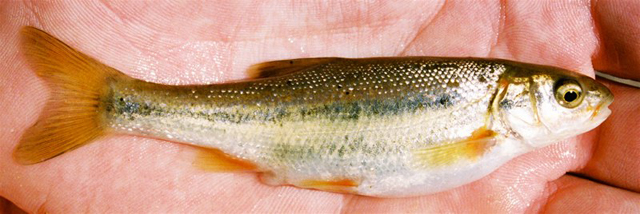| Leuciscidae (Minnows), subfamily: Laviniinae |
| 18 cm TL (male/unsexed) |
|
benthopelagic; freshwater |
| North America: Upper Rio Grande and Pecos River systems in Colorado and New Mexico, USA; isolated populations in Davis Mountains (Pecos River system) in Texas, USA. Introduced into headwaters of Canadian River (Red River drainage) in New Mexico. |
|
Dorsal soft rays (total): 8-8; Anal soft rays: 8-8. Gila pandora can be distinguished by the following characters: lateral line with 51-67 scales; dorsal fin with 8 rays; anal fin with 8 rays; 1st gill arch with 6-10 rakers; pharyngeal teeth 2,5-4,2; slightly subterminal mouth, extending to front of large eye; rounded, fairly blunt snout; fairly deep, compressed body; deep caudal peduncle; olive-gray above; 2 dusky stripes along silver sides (darkest on large individual), upper one extending to caudal fin, lower one to anal fin; and dusky to black caudal spot. Breeding individuals with red-orange (brightest in males) anal, dorsal and paired fin bases and side of head; orange lower side (Ref. 86798). |
| Inhabits flowing pools of headwaters, creeks and small rivers. Occurs usually near brush (Ref. 5723, 86798). Mid-water carnivore; feeds on zooplankton, aquatic and terrestrial insects, crustaceans, juvenile fish, and a limited amount of detritus (Ref. 79012). |
|
Least Concern (LC); Date assessed: 09 February 2012 Ref. (130435)
|
| harmless |
|
Source and more info: www.fishbase.org. For personal, classroom, and other internal use only. Not for publication.

